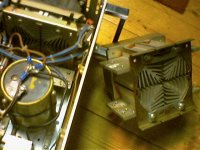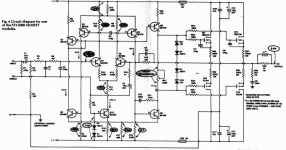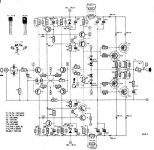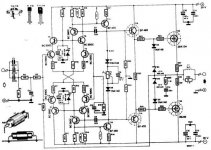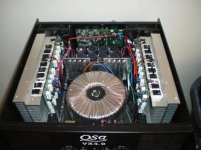Last picture for those of you that don't know such a cool(ing?)-tunnel. I have another one on stock, but that one is for 8 TO3's.
The four heatsinks are isolated from frame, so you dont need isolators between the transistors and the metal (at least not in the 4 TO version, here it's two TO3's per heatsink).
For playing music these days, i have an amp with the same age: AudioAnalyse B90mk2. The 'black bat' class-a amp with tube pre.
The four heatsinks are isolated from frame, so you dont need isolators between the transistors and the metal (at least not in the 4 TO version, here it's two TO3's per heatsink).
For playing music these days, i have an amp with the same age: AudioAnalyse B90mk2. The 'black bat' class-a amp with tube pre.
Attachments
I still have the svenska's to go with the amp. Jamo disco line before philips got involved. Also not a nice thing for the neighbours / neighbourhood. I needed to 'test' the amp now and then to see if it was ok for a party in the evening, at least that was my excuse. The woofers of those svenska's need fixing, the foam ring around the speaker turned to dust at my last 'testrun'.
Question for all: how far can i get if i use that cooling-tunnel with a quiet fan (or run a normal fan at reduced revs). Any good for a livingroom amp? The papst fan in the amp is not quiet
Question for all: how far can i get if i use that cooling-tunnel with a quiet fan (or run a normal fan at reduced revs). Any good for a livingroom amp? The papst fan in the amp is not quiet

Guido,
there is a heatsink excel calculator to download on one of the threads. Rod Elliot has a simpler one at his site.
Depending on the geometry of the heatsink the maximum obtainably with a cooling duct is a reduction of the static heat resistance of 1 : 6.
The parameters to obtain that are:
blank heatsinks, no air gaps in the cooling duct, high air velocity,
no laminair flows but pure turbulent.
With average heatsinks and normal fans it reduces to 1 : 3.
I did fluid flows and heat transfer colleges at Delft polytech, at the time i experimented some with heatsinks, ducts, and vents
for the fun and to see how far i could go with a class A amplifier and a cooling duct.
If you like to estimate it more accurately, there is a graph for thermal resistance versus air velocity here somewhere too.
Some time ago i bought 20 new alloy Papst 30dBA vents for $5
the piece.
With reduced air velocity that vent is hardly noticeable, and lasts a century.
there is a heatsink excel calculator to download on one of the threads. Rod Elliot has a simpler one at his site.
Depending on the geometry of the heatsink the maximum obtainably with a cooling duct is a reduction of the static heat resistance of 1 : 6.
The parameters to obtain that are:
blank heatsinks, no air gaps in the cooling duct, high air velocity,
no laminair flows but pure turbulent.
With average heatsinks and normal fans it reduces to 1 : 3.
I did fluid flows and heat transfer colleges at Delft polytech, at the time i experimented some with heatsinks, ducts, and vents
for the fun and to see how far i could go with a class A amplifier and a cooling duct.
If you like to estimate it more accurately, there is a graph for thermal resistance versus air velocity here somewhere too.
Some time ago i bought 20 new alloy Papst 30dBA vents for $5
the piece.
With reduced air velocity that vent is hardly noticeable, and lasts a century.
Sorry COBRA !! Poor pic quality after compressing Can u please mail it to >> floyds_ec@gawab.com
THANX!!
THANX!!
Here is the AXL.
This one i built, using the 135/50.
Intended for 60% class A at 30V or in AB at 45V.
I added two Mosfets, with 1.8A bias at 30V it did 25 watts class A both in 8 and in 4 Ohm like the ML2.
Before building it in a chassis i had it on a wooden panel with dual powersupplies.
Switching from one channel in class A to the second in AB with a relay enabled me to compare.
First time i noticed Mosfets sound cold and hard in AB, warm and soft in class A, by the end of the 80s opamp/mosfet designs made this even more apparent.
This one i built, using the 135/50.
Intended for 60% class A at 30V or in AB at 45V.
I added two Mosfets, with 1.8A bias at 30V it did 25 watts class A both in 8 and in 4 Ohm like the ML2.
Before building it in a chassis i had it on a wooden panel with dual powersupplies.
Switching from one channel in class A to the second in AB with a relay enabled me to compare.
First time i noticed Mosfets sound cold and hard in AB, warm and soft in class A, by the end of the 80s opamp/mosfet designs made this even more apparent.
Attachments
AXL amplifier
Of course I'm refering to the previous one, not the AXL....
How was the quality of the AXL, I've never had a chance to build it,
actually I was considering that when this discussion started...
How was the quality compared to the Crescendo?
Do you think It's worth to bother with it?
Of course I'm refering to the previous one, not the AXL....
How was the quality of the AXL, I've never had a chance to build it,
actually I was considering that when this discussion started...
How was the quality compared to the Crescendo?
Do you think It's worth to bother with it?
Re: AXL amplifier
Sorry for answering this late.
I never liked the Crescendo, when it had just come out i thought about building it for my first diy preamp, but was advised not by my DIY buddy, a professional electronic with absolute hearing and 25 years more age and experience.
The AXL was quite good then i think, later i tried the 1985 RadioBulletin's 20 watt class A, it outperformed the AXL.
The 20-watter was designed by Menno van der Veen, now the transformer guru at Plitron and Amplimo.
The 20 watt class A is easy to find on the web.
I still think they are both worth the build because they were cheap and easy to build, Hitachi Mosfets were the easiest to buy power devices in the '80s.
My friend gave me 2 Toroidal transformers for no charge, in the 1980s i was a poor polytech student.
At the time i had to use autocad R10 to R13 to design PCB's, Xeroxing the layout on transparents or PCB-foil was easier.
The Crescendo i would not recommend, many state that it was notorious to oscillate, in '82 it was one of the few high-power DIY designs.
Its successor seems to be a lot better, after trying the 1st edition i never bothered.
I do not dare recommending it with the JLH on this forum.
But if, like me, you still have some Hitachi 48/49/50/133/134/135
Mosfets, it is fun to try them.
The best investment i made was buying a used Variac.
jmateus said:How was the quality compared to the Crescendo?
Sorry for answering this late.
I never liked the Crescendo, when it had just come out i thought about building it for my first diy preamp, but was advised not by my DIY buddy, a professional electronic with absolute hearing and 25 years more age and experience.
The AXL was quite good then i think, later i tried the 1985 RadioBulletin's 20 watt class A, it outperformed the AXL.
The 20-watter was designed by Menno van der Veen, now the transformer guru at Plitron and Amplimo.
The 20 watt class A is easy to find on the web.
I still think they are both worth the build because they were cheap and easy to build, Hitachi Mosfets were the easiest to buy power devices in the '80s.
My friend gave me 2 Toroidal transformers for no charge, in the 1980s i was a poor polytech student.
At the time i had to use autocad R10 to R13 to design PCB's, Xeroxing the layout on transparents or PCB-foil was easier.
The Crescendo i would not recommend, many state that it was notorious to oscillate, in '82 it was one of the few high-power DIY designs.
Its successor seems to be a lot better, after trying the 1st edition i never bothered.
I do not dare recommending it with the JLH on this forum.
But if, like me, you still have some Hitachi 48/49/50/133/134/135
Mosfets, it is fun to try them.
The best investment i made was buying a used Variac.
Modify it and use it as a torroid...I did ...Jaac wrote: The best investment i made was buying a used Variac.
PS: 2nd hand variac's are cheap ,Remove the brush assembly..Wrap it with a good insulating material, then Wind the secondary over it..
Crescendo and more....
Hello Jacco
Indeed I have a similar opinion about the Crescendo and this is why
this amplifier never saw the mains voltage for a few years, until a
week ago! This is funny because when I plugged it in I was sensing
already a feeling of disappointment, phsycologically I was sensing
something wrong...And there it was, the sound that I forgot for a
few years was disappointing to me again...
Among several amplifiers that I built for so many years, I keep with
a certain sense of gratitude the big JLH, class A , that came into life
two years ago, and if I don't favour it over the tube amplifiers that
my "factory" produced, it is however my best solid state amp, inclu-
ding in this number another pair of JFET monoblocks that I built
according to a design of Mr. Slone which I considered a very good one...
Anyway, now comes the big slam! Have you heard about the class
D amplifiers? Or more specifically about the class T amps? I am
reading all there is about this technology and I am impressed....
I have a friend who already heard a class D amplifier and is saying
wonders about it...Woul I say the same? I don' t know...I'm waiting
and I'm hopping that I won't be disappointed.....
Hello Jacco
Indeed I have a similar opinion about the Crescendo and this is why
this amplifier never saw the mains voltage for a few years, until a
week ago! This is funny because when I plugged it in I was sensing
already a feeling of disappointment, phsycologically I was sensing
something wrong...And there it was, the sound that I forgot for a
few years was disappointing to me again...
Among several amplifiers that I built for so many years, I keep with
a certain sense of gratitude the big JLH, class A , that came into life
two years ago, and if I don't favour it over the tube amplifiers that
my "factory" produced, it is however my best solid state amp, inclu-
ding in this number another pair of JFET monoblocks that I built
according to a design of Mr. Slone which I considered a very good one...
Anyway, now comes the big slam! Have you heard about the class
D amplifiers? Or more specifically about the class T amps? I am
reading all there is about this technology and I am impressed....
I have a friend who already heard a class D amplifier and is saying
wonders about it...Woul I say the same? I don' t know...I'm waiting
and I'm hopping that I won't be disappointed.....
Please help...post mar 85 - AXL with 2SK134/2SJ49
jacco.... please post mar 85 - AXL with 2SK134/2SJ49, schematic and pcb (if possible). I have built my AXL in 1997, and now it has problem with the 100mfd electrolit capacitor. It just blew...and I am afraid there's something wrong with other circuit parts. Unfortunately, I lost my magazine. Please help me out....my mail is ynotthea@yahoo.com
thanks in advance
tony
indonesia
jacco.... please post mar 85 - AXL with 2SK134/2SJ49, schematic and pcb (if possible). I have built my AXL in 1997, and now it has problem with the 100mfd electrolit capacitor. It just blew...and I am afraid there's something wrong with other circuit parts. Unfortunately, I lost my magazine. Please help me out....my mail is ynotthea@yahoo.com
thanks in advance
tony
indonesia
I builld 2007 in chinese Factory 20 pcs. Elektor Crescendo Amp for PA with IRFP9240 /IRFP240 Mosfets.
The Sound from Crescendo is more warm and natural
The mosfet amp is working very stable, but the sound from Class D is more powerful in bass and clear in High Frequency.
The Sound from Crescendo is more warm and natural
The mosfet amp is working very stable, but the sound from Class D is more powerful in bass and clear in High Frequency.
Attachments
- Status
- This old topic is closed. If you want to reopen this topic, contact a moderator using the "Report Post" button.
- Home
- More Vendors...
- Elektor
- I need comments about "100W power amp. elektor april 1982"
